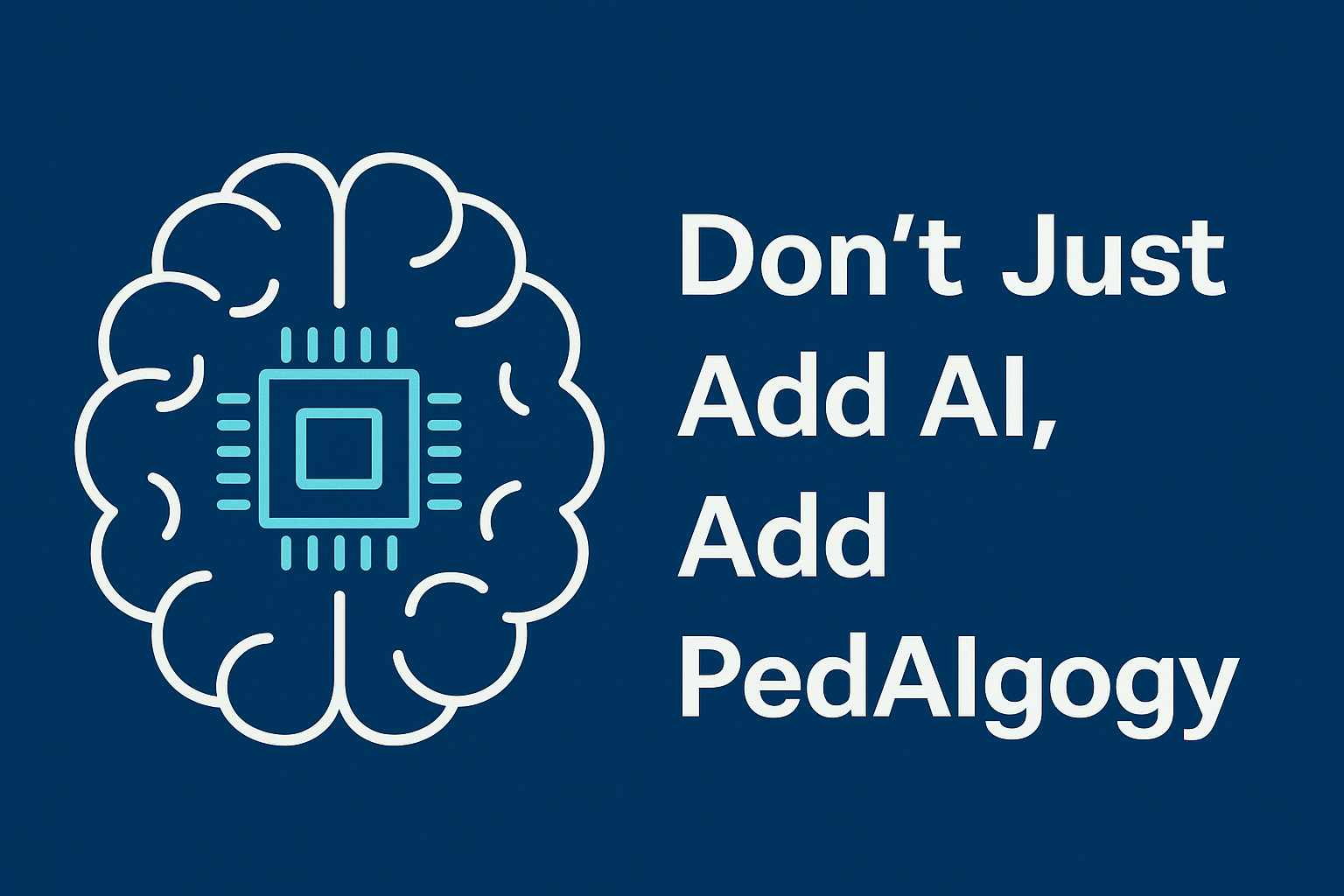With generative AI advancing at such a rapid pace and continually offering new opportunities to integrate it into our everyday lives, there’s a risk that we might overlook something fundamental: the pedagogy behind our educational practices. Are we becoming so focused on what AI can do that we forget about why, and how, we teach and learn?
If you’ve been following my recent posts on the Kent Learn-Tech blog, you’ll know I’ve been exploring how generative AI can actively reshape the way learners engage with content. I’ve previously discussed the limitations of passive approaches to asynchronous learning, think ‘watch this video, take this quiz’, and suggested ways we might create richer, more engaging experiences. Today, I’d like to introduce the concept of PedAIgogy.
What is PedAIgogy?
PedAIgogy involves thoughtfully integrating AI into established pedagogical practices, aiming to actively enhance, not replace, learner experiences. It’s grounded firmly in educational theory, viewing AI through the lens of well-established learning principles and practices.
Key Educational Theories
Before diving deeper, let’s revisit some foundational educational theories that underpin effective learning:
Constructivism (Jean Piaget, Lev Vygotsky): Learners actively construct their own understanding through exploration, interaction, and reflection.
Social Learning Theory (Albert Bandura): Learning occurs through observation, imitation, and collaboration with peers.
Cognitivism (Jerome Bruner, David Ausubel): Emphasises internal cognitive processes like organisation, summarisation, and connecting new information to existing knowledge.
Behaviourism (B.F. Skinner, Ivan Pavlov): Learning is shaped through reinforcement, feedback, and repetition.
Connectivism (George Siemens, Stephen Downes): In a digital age, learning takes place across networks and systems. Knowledge is distributed, and learning involves recognising connections between fields, ideas, and concepts, often supported by technology.
How PedAIgogy Enhances These Theories
It’s worth noting that while we often talk about AI supporting learning through various theoretical lenses, we must be thoughtful about how these are interpreted. For example, Social Learning Theory, developed by Albert Bandura, emphasises learning through observation, imitation, and interaction with others, human others. In this sense, AI cannot directly replicate the social dimension of learning. However, AI can still play a valuable role in facilitating human-to-human collaboration, providing prompts, feedback structures, and tools that support socially constructed knowledge. What matters is not the AI alone, but how it is used to support pedagogical intent.
PedAIgogy isn’t just a buzzword, it’s a practical approach to enriching each of the major learning theories with the power of AI. Here’s how:
- Constructivism: AI fosters active engagement by encouraging learners to explore and construct their own understanding. Tools like adaptive learning platforms and interactive simulations challenge students to solve problems, investigate ideas, and refine their thinking through trial and error.
- Social Learning Theory: While AI cannot replicate human interaction, it can support Social Learning by helping students prepare for and engage more meaningfully in collaborative tasks. For example, AI can guide students in generating self-reflection questions or feedback prompts before peer review activities, improving the quality of their contributions. This helps scaffold peer dialogue and shared knowledge construction, aligning with the social and observational principles at the heart of Social Learning Theory.
- Cognitivism: AI tools such as Notion AI, Notebook LM or Connected Papers help students organise complex information, generate summaries, and visualise how ideas relate across sources. These tools align with Cognitivist principles by supporting memory organisation, deep processing, and reflective learning.
- Behaviourism: AI-driven feedback systems deliver real-time, personalised feedback, reinforcing learning through repetition and correction. Whether it’s a grammar checker, a quiz generator with immediate scoring, or spaced repetition tools, AI ensures learners receive consistent and timely input that helps shape behaviour and retention.
- Connectivism: AI supports Connectivist learning by helping students discover, filter, and connect ideas across vast networks of information. Tools like Elicit and Notebook LM help learners form connections between seemingly unrelated domains. This mirrors how knowledge is distributed in the digital age, and how learning often involves navigating and synthesising ideas from multiple sources, not just recalling facts from memory.
By intentionally aligning AI tools with these pedagogical foundations, educators can create environments that support a more responsive, engaging, and inclusive learning experience. Ultimately, it’s the pedagogical design that determines whether AI has a meaningful impact. The value of a tool lies not in its features, but in how intentionally it is used to support specific learning goals.
Practical Examples of PedAIgogy in Action
So far, we’ve explored how PedAIgogy draws on educational theory to frame the integration of AI tools in ways that genuinely enhance learning. But what does this look like in real teaching scenarios? In this section, we’ll explore concrete examples that bring PedAIgogy to life, showcasing how thoughtful use of AI can align with your pedagogical aims while transforming learner engagement.
Example: Creating a Socratic AI Tutor (Linked to Constructivism and Cognitivism)
Imagine you’re revising for an exam. A PedAIgogy approach might involve asking an AI tool to take on the role of a Socratic tutor, guiding you towards discovering answers through probing questions and reflective dialogue rather than simply providing solutions.
This aligns closely with Constructivist learning theory, which emphasises learners constructing their own understanding through active engagement and reflection. By posing questions instead of giving answers, the AI supports the learner’s own sense-making process. At the same time, this approach draws on Cognitivist principles by helping learners identify gaps in their understanding, organise their thoughts, and strengthen cognitive connections.
I’ve experienced this firsthand. I once spent hours reviewing flashcards on cell biology, feeling totally prepared, only to realise in the exam I couldn’t clearly explain the difference between mitosis and meiosis without my notes. A Socratic AI tutor prompts you to articulate understanding and proactively identify misconceptions, ensuring genuine comprehension and preparedness.
A recent development in this space is Anthropic’s launch of Claude for Education, which includes a “Learning Mode” specifically designed to foster critical thinking through Socratic dialogue. Instead of offering direct answers, Claude encourages learners to reflect, reason, and justify their thinking, asking questions like “How would you approach this problem?” or “What assumptions are you making?” This approach has already been adopted by institutions such as Northeastern University and the London School of Economics.
While Anthropic’s tool is a strong example of purpose-built Socratic tutoring, it’s important to note that similar approaches can be implemented in most AI tools, including ChatGPT, Gemini, and Copilot. What matters most is the prompt design, guiding the AI to act as a reflective partner rather than a direct answer-giver.
Try these prompts to set up your own Socratic AI tutor:
- “Pretend you are my tutor and help me understand [topic]. Don’t give me the answer directly; instead, ask me questions to guide my thinking.”
- “I want to test my understanding of [concept]. Please ask me challenging questions to help me reflect and deepen my comprehension.”
- “I need to revise [subject area]. Can you ask me progressively deeper questions, so I can discover any gaps in my knowledge?”
Another easy way to implement a Socratic AI tutor is by creating your own custom GPT using OpenAI’s platform. This straightforward approach lets you define precisely how your AI tutor interacts with learners, ensuring a tailored and effective learning experience.
Example: Using AI to Curate and Connect Ideas (Linked to Connectivism)
Imagine you’re working on a sports science assignment about how psychological factors influence endurance performance. You’re finding it difficult to connect ideas across different subfields, like motivation theory, stress responses, and pacing strategies.
You ask an AI tool to help you explore how these areas relate. The AI suggests that motivation theory may influence how athletes respond to physical stress, and that stress can, in turn, affect their pacing decisions. It surfaces relevant research, prompts follow-up questions like “How does perceived exertion differ from physiological fatigue?” and suggests additional terms you might explore, such as “self-regulation” and “anticipatory responses.”
This kind of interaction doesn’t just retrieve information, it helps you make connections across concepts you might not have linked on your own.
This approach aligns with Connectivism, a theory which recognises that in a digital age, learning is no longer confined to the individual. Instead, it takes place across networks, and knowledge-building involves navigating, filtering, and connecting ideas from a wide range of digital and human sources. Here, AI acts as an extension of the learner’s cognitive process, supporting deeper inquiry and interdisciplinary thinking.
Challenges and Opportunities
Introducing PedAIgogy does come with challenges, such as ensuring staff have the pedagogical knowledge, and students the AI literacy and reflective habits, needed to use AI effectively and meaningfully. It’s important to acknowledge wider concerns about overreliance on AI or learners engaging superficially with content. However, PedAIgogy, by its very design, acts as a countermeasure to these risks.
Approaches like the Socratic AI tutor model actively promote critical thinking, metacognitive reflection (that is, thinking about how and why they are learning, and evaluating their own understanding and strategies), and learner autonomy. Instead of replacing human thought, they prompt learners to work through ideas, examine their assumptions, and articulate their reasoning. In other words, they help shift learners from asking “What’s the answer?” to “Why is that the answer, and how do I know?”, a hallmark of deeper, more reflective learning. In this way, PedAIgogy helps learners use AI as a catalyst for deeper engagement rather than as a shortcut.
PedAIgogy provides personalised learning experiences, encourages independent and collaborative learning, and deeply engages learners by meaningfully embedding AI into pedagogical practice. With the right scaffolding and purpose, AI can enhance rather than hinder deep learning. In many ways, PedAIgogy could be seen as a practical realisation of Connectivism, helping learners not only absorb content but navigate, connect, and co-construct knowledge across digital spaces.
Ultimately, PedAIgogy is not about AI replacing traditional pedagogical approaches, it’s about effectively integrating AI within these frameworks to enrich and transform the educational experience.

